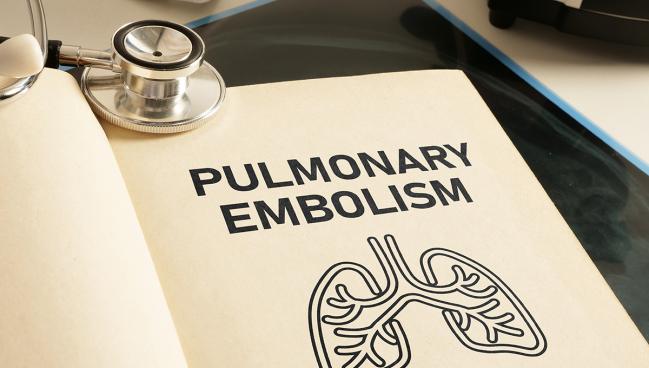Different Guidelines for Acute PE Offer a Mixed Bag of Advice
A new review finds harmony and dissonance, as well as omissions, among US and European recommendations.

Guideline recommendations for acute pulmonary embolism (PE) developed by prominent professional societies give a mixed bag of advice across the US and Europe, according to a paper published online this week in the Journal of the American College of Cardiology.
Researchers considered numerous clinical guidelines authored by the European Society of Cardiology and European Respiratory Society (ESC/ERS), Pulmonary Embolism Response Team (PERT) Consortium, CHEST (previously referred to as the American College of Chest Physicians guidelines), American Heart Association (AHA), American Society of Hematology (ASH), and National Institute for Health and Care Excellence (NICE).
Clinicians may find themselves flummoxed by the number of documents to choose from and the heterogeneity of the recommendations therein, as well as “areas of uncertainty or omission,” the authors note. The situation “may leave the readers and clinicians without a clear management pathway.”
Their focus in reviewing the various documents, Behnood Bikdeli, MD (Brigham and Women’s Hospital, Boston, MA, and Yale New Haven Hospital/Yale Center for Outcomes Research and Evaluation, CT), told TCTMD, was to further “evidence generation and assessment to improve patient care. . . . It’s not just the dissonance [between guidelines] that bothered us. Sometimes even the silence, to us, was an opportunity for improvement. Thankfully there was a lot of agreement as well. ”
They teased out similarities and differences related to diagnosis, short-term management, procedural treatment, and long-term follow-up, he explained. “How are all of these different guidelines handling those? [These are] going to be what a lot of day-to-day clinicians seek guidance from in order to help patients make informed decisions,” said Bikdeli, who served as first author along with Marco Zuin, MD (University of Ferrara and University of Padova, Italy).
“Despite abundant clinical innovation and burgeoning scientific investigation, PE has continued to pose a diagnostic and management challenge worldwide,” with a burden that’s only expected to grow, the paper notes. “In the meantime, navigating expanding strategies for immediate and long-term anticoagulation, as well as advanced therapies, including catheter-based interventions for patients with more severe PE, has become progressively daunting.”
Indeed, “in the past two decades, we’ve been blessed with a plethora of options for endovascular management of PE, but also we have to be cognizant, besides the enthusiasm, that the evidence hasn’t necessarily caught up yet in terms of how they’re going to impact patient outcomes,” said Bikdeli. “How that is going to be reflected in [future] guidelines is a key issue,” he added.
Some Overlap Seen
Agreement among the array of US and European guidelines is weakest when it comes to lifestyle and systemic fibrinolysis dose, the review found, but there also are variations related to risk stratification, diagnosis of chronic thromboembolic disease and chronic thromboembolic pulmonary hypertension during follow-up, the role of early discharge and home-based care for low-risk PE, and the use of catheter-directed interventions in intermediate-risk patients with hemodynamic and/or respiratory worsening.
Yet there is nearly 100% concordance for:
- Anticoagulation’s role as the mainstay therapy for all patients without contraindication
- The use of inferior vena cava filters in patients with acute venous thromboembolism who have contraindication to anticoagulation
- Identification of low-risk PE
- The use of risk scores and D-dimer to rule out PE in patients with low/intermediate pretest probability
- The need for systematic fibrinolysis in hemodynamically unstable PE
Part of the inconsistency, said Bikdeli, arises from the reality of “these guidelines not [all] being published at the same time.” The AHA, though currently in the process of updating its advice, most recently issued PE guidelines in 2011, he noted, whereas the NICE document came out just last year.
What will be key moving forward is strengthening the evidence base, he commented.
For example, the multidisciplinary PERT approach to management is a “very intuitive concept,” Bikdeli pointed out. “It just makes sense that it brings something positive to the table, with the caveat that even for something as elegant as this, we would always love to see robust, prospective data to support some sort of improvement either in process measures or in hard clinical outcomes. Except for some indirect pieces of evidence, that [data]’s not there,” which is likely why some guidelines didn’t give PERTs a hearty endorsement, he said.
Among the documents, “only ESC/ERS and PERT advocate for their role, recommending consideration of establishing PERTs when resources permit,” the review notes.
Bit by bit, however, data on the best strategies for addressing PE have begun to accrue. For instance, the upcoming TCT 2024 meeting later this month will feature late-breaking results from the PEERLESS randomized trial of large-bore mechanical thrombectomy versus catheter-directed thrombolysis for intermediate-risk PE. Tools for percutaneous thrombectomy, too, are under study.
“I think there is a need for these different tools in different patients,” said Bikdeli. “The real question is, do we need them in all comers?” While awaiting high-quality evidence on interventions, the recommendations from the various groups remain mixed here, too, he added.
What happens after treatment in regard to transition of care and follow-up also merits further study, he stressed, as much of the advice is extrapolated from other cardiovascular or medical settings.
Patients have many questions about things like how much physical activity is safe or what risk factors they should monitor, said Bikdeli. “This is the area where we have the biggest gap in knowledge. . . . I really hope over the next several years there is going to be more attention to this unmet need of: what do we do after this acute phase for people who are still having lingering symptoms? How do we guide them to get back to their routine?”
The amount of information out there on PE, even with the knowledge gaps, can be overwhelming, Bikdeli acknowledged. Readers looking for a concise summary of current thinking—how it converges and how it diverges—can check out the illustrations within their review, he added.
Caitlin E. Cox is News Editor of TCTMD and Associate Director, Editorial Content at the Cardiovascular Research Foundation. She produces the…
Read Full BioSources
Zuin M, Bikdeli B, Ballard-Hernandez J, et al. International clinical practice guideline recommendations for acute pulmonary embolism: harmony, dissonance, and silence. JACC. 2024;84:1561-1577.
Disclosures
- Zuin reports no relevant conflicts of interest.
- Bikdeli reports having received support from a Career Development Award from the American Heart Association and VIVA Physicians; the Scott Schoen and Nancy Adams IGNITE Award; the Mary Ann Tynan Research Scientist award from the Mary Horrigan Connors Center for Women’s Health and Gender Biology at Brigham and Women’s Hospital; and the Heart and Vascular Center Junior Faculty Award from Brigham and Women’s Hospital. He has been a consulting expert, on behalf of the plaintiff, for litigation related to two specific brand models of IVC filters (he has not been involved in the litigation in 2022-2024 nor has he received any compensation in 2022-2024); is a member of the Medical Advisory Board for the North American Thrombosis Forum; serves on the Data Safety and Monitory Board of the NAIL-IT trial funded by the National Heart, Lung, and Blood Institute, and Translational Sciences; and is a collaborating consultant with the International Consulting Associates and the US Food and Drug Administration in study to generate knowledge about utilization, predictors, retrieval, and safety of IVC filters.





Comments